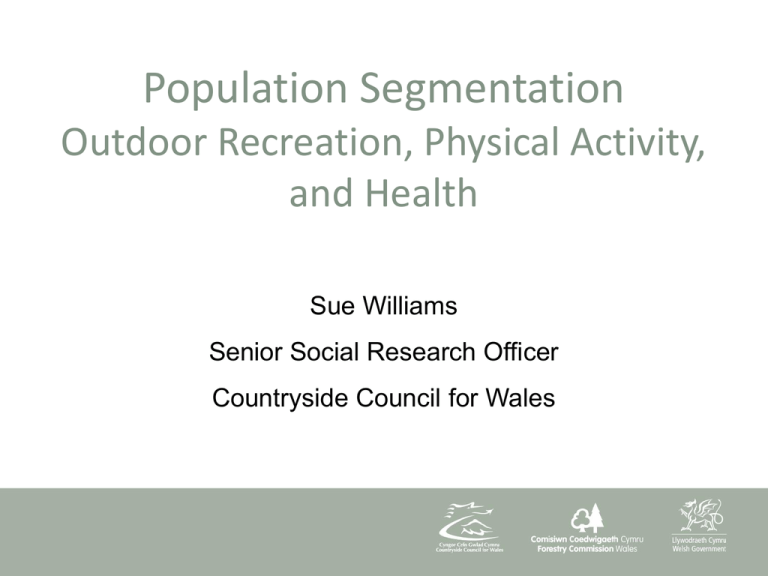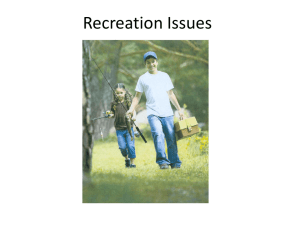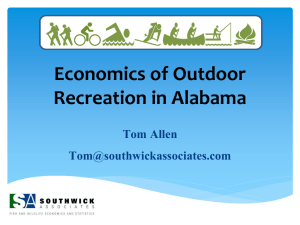Outdoor Recreation, Physical Activity, and Health
advertisement

Population Segmentation Outdoor Recreation, Physical Activity, and Health Sue Williams Senior Social Research Officer Countryside Council for Wales Population Segmentation: Outdoor Recreation, Physical Activity, and Health Aim of analysis: Understanding the relationship between: • participation in outdoor recreation; • levels of physical activity; • derived health benefits Population Segmentation: Outdoor Recreation, Physical Activity, and Health Analysis based on data from the Welsh Outdoor Recreation Survey: • Household Survey of over 6000 residents of Wales • 12 months continuous fieldwork • Representative of the adult population of Wales • Detailed questionnaire covering all aspects of recreation, physical activity and demographics Population Segmentation: Outdoor Recreation, Physical Activity, and Health Methodology: Multivariate analysis based on interaction between 3 variables: • Frequency (5 x week) • Duration (150+ minutes / week) • Intensity (moderate to high) Population Segmentation: Outdoor Recreation, Physical Activity, and Health 7 segments fit into 3 ‘Zones’: Red Zone Amber Zone Green Zone 14% of pop’n 56% of pop’n 29% of pop’n 2 segments 3 segments 2 segments Least Active Low to Moderate activity Highly Active No / limited health benefits Some health benefits Maximum health benefits Population Segmentation: Outdoor Recreation, Physical Activity, and Health Red Zone Segment 1: Non-Participants. 6% • Combination of old age + disability • Associated ‘lifestyle’ factors: no car, no qualifications, retired • No difference between men and women • Not related to deprivation (Community First, WIMD) • Very low level of Latent Demand • Barriers: combination of ‘Disability’ + ‘Poor Health’ + ‘Old Age’ Population Segmentation: Outdoor Recreation, Physical Activity, and Health Red Zone Segment 2: Rare Participants. 8% • Similar to ‘non-participants’ re old age + disability • BUT … also include ‘middle-aged’ and ‘working’ • ‘Passive’ activities • Most likely to live in an urban area, but not related to deprivation (Community First, WIMD) • High level of Latent Demand for ‘passive’ pursuits • Main Barriers: ‘Too Busy’ + ‘No Reason’ or ‘Poor Health’ + ‘Old Age’ Population Segmentation: Outdoor Recreation, Physical Activity, and Health Amber Zone Segment 3: Infrequent, Low Intensity Participants. 9% • Women with children; Not a dog owner • Not related to deprivation (Community First, WIMD) or location • ‘Passive’ pursuits, motivated by ‘entertaining children’ • Visits Playgrounds, Local parks, Beaches • Moderately high level of Latent Demand • Main Barrier: ‘Too Busy’ Population Segmentation: Outdoor Recreation, Physical Activity, and Health Amber Zone Segment 4: Frequent, Low Intensity Participants. 21% • Dog owners; No children • Rural residents, but not related to deprivation (Community First, WIMD) • ‘Walking’ in local areas (Parks and Farmland) • Motivated by functional needs: ‘To walk the dog’ • Low level of Latent Demand • Main Barriers: ‘Too Busy’ and ‘No Reason’ Population Segmentation: Outdoor Recreation, Physical Activity, and Health Amber Zone Segment 5: High Intensity, Infrequent, Under 150 min. 26% • Young /middle ages (25-44); educated, working and affluent • Neither location nor deprivation have any effect • ‘Active’ pursuits: running and cycling, in local areas (parks and roadside tracks) • Motivated by ‘Health and Exercise’ • High level of Latent Demand • Main Barriers: ‘Too Busy’ Population Segmentation: Outdoor Recreation, Physical Activity, and Health Green Zone Segment 6: High Intensity, Infrequent, Over 150 min. 12% • Men, middle-aged, with children, no dog • Highly educated and working • No difference re rural / urban or Community First, but in top 10% WIMD • ‘Active’ pursuits and ‘Days Out’ – mountains, woods, coast • Motivated by ‘Participating in my Hobby’ and ‘Scenery’ • High level of Latent Demand • Main Barriers: ‘Too Busy’ and ‘Lack of Places to Go’ Population Segmentation: Outdoor Recreation, Physical Activity, and Health Green Zone Segment 7: High Intensity, Frequent Participants. 17% • Dog owners, living in rural areas, and in top 10% WIMD • No difference between men / women, having children or a car, or Community First Areas • Diversity of ‘Active’ pursuits: running, cycling, horse riding • Different locations: Woods, Mountains, Farmland • Range of motivations: ‘Health’, ‘Hobbies’, ‘Exercising Dog’ • Lowest level of Latent Demand • Main Barriers: ‘Too Busy’ Population Segmentation: Outdoor Recreation, Physical Activity, and Health So … which groups participate less? … there isn’t a simple answer! • Multiple attributes (combinations of age, disabilities, genders, children, dog ownership and working status) • Demographics have the greatest effect … followed by ‘lifestyle’ factors • ‘Geography’ (where you live) has the least effect Population Segmentation: Outdoor Recreation, Physical Activity, and Health Non-participation associated with: • combination of old age, disability and poor health • but also those who are busy with low motivation Low participation associated with: • women who have children, but no dog Low intensity associated with: • dog owners (also likely to be older women) Short duration associated with: • educated, affluent, working adults, who are too busy Population Segmentation: Outdoor Recreation, Physical Activity, and Health Key challenges: Who should we target? • Single demographic groups? • Multiple demographic / lifestyle groups? • ‘lifestage’ groups rather than geographical areas? Which level should we focus on: • Absolute non-participants? • Limited participants? • Maintain active participants Population Segmentation: Outdoor Recreation, Physical Activity, and Health Full survey results are on CCW’s website: http://www.ccw.gov.uk/enjoying-the-country/welshoutdoorrecreation-survey.aspx Enquires: Sue Williams e-mail: su.williams@ccw.gov.uk Tel: 01248 387386






